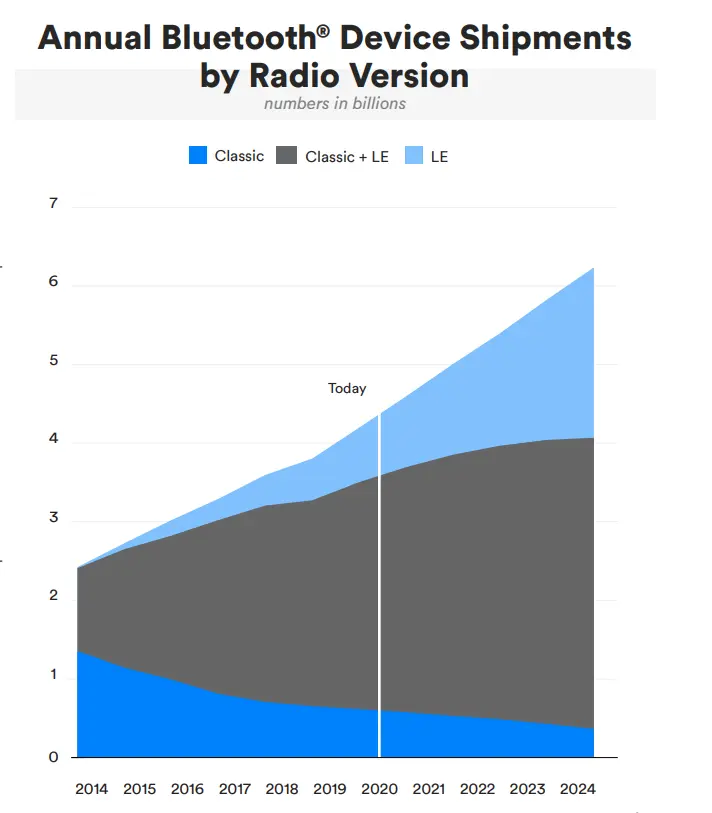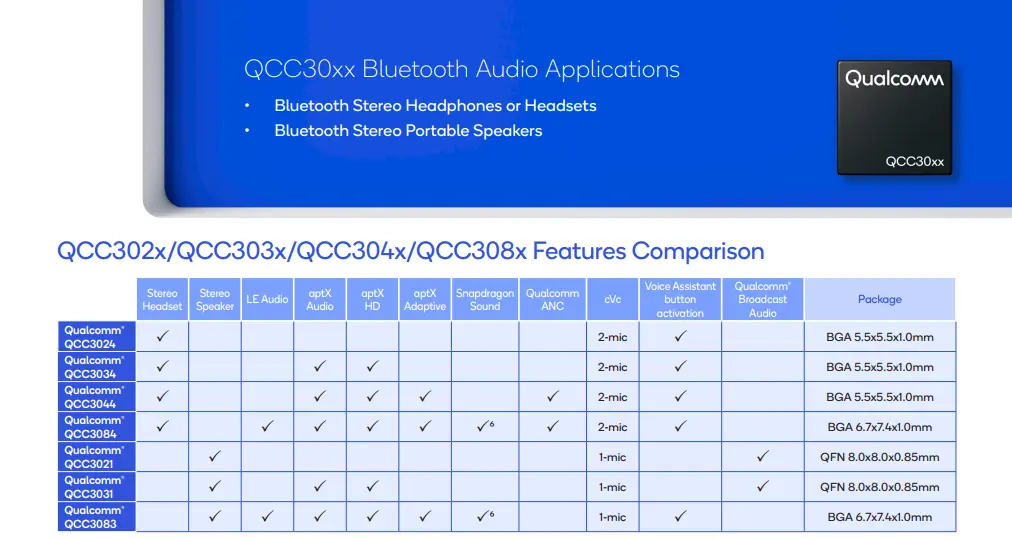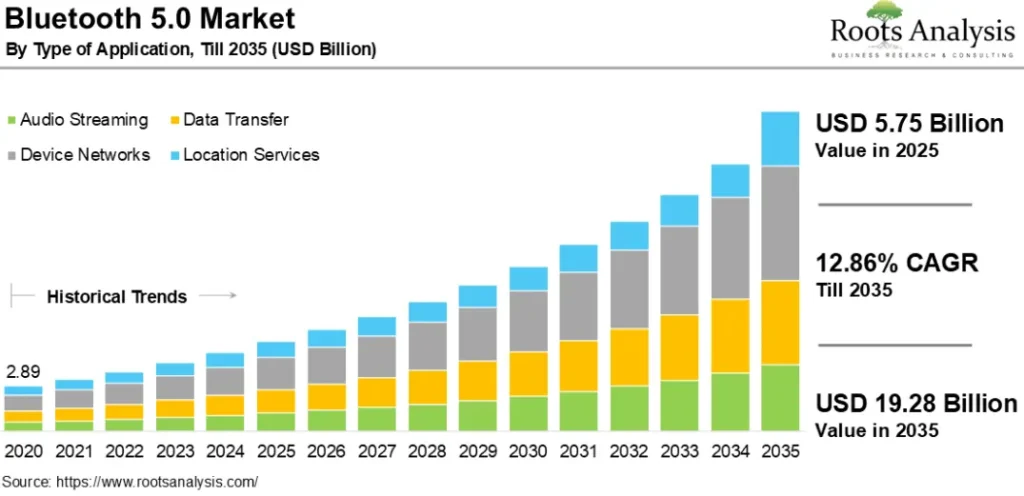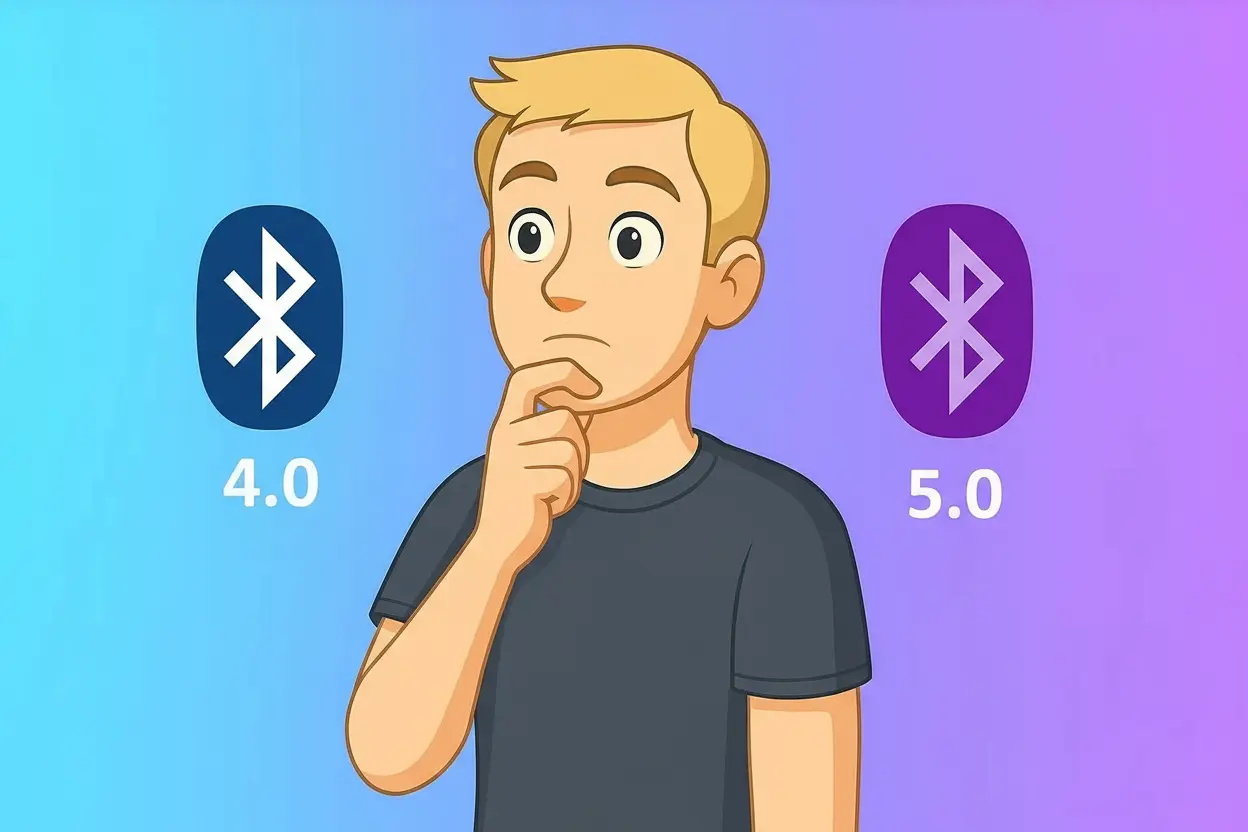Your Bluetooth connection cuts out during a playlist. Your wireless earbuds take three seconds to respond to a tap. Your smart home hub struggles to reach sensors across your apartment. These frustrations often point to the same cause: an older Bluetooth version on your device.
Bluetooth 4.0 and 5.0 represent two major generational shifts in wireless connectivity. If you are shopping for headphones, speakers, or smart devices, or if you wonder whether your current gear is outdated, you need to know what separates these standards.
This guide explains the key differences between Bluetooth 4.0 and 5.0. We cover range, speed, power efficiency, backward compatibility, and device recommendations to help you decide whether to upgrade, keep your current device, or make informed purchases.
Key Takeaways
- Bluetooth 4.0 reaches 50 meters at 1 Mbps, and Bluetooth 5.0 reaches over 200 meters at 2 Mbps.
- Backward compatibility is built in. Your 4.0 and 5.0 devices will pair together, though the connection uses 4.0 specs.
- LE Audio (5.0) enables higher-bitrate streaming, but 4.0 devices with aptX codecs may sound better than basic 5.0 headphones.
- Battery life improves with 5.0. Expect 10 to 20% longer runtime on 5.0 smartwatches and IoT devices.
- Buy 5.0 when replacing devices; don’t overhaul your ecosystem overnight.
- IoT and smart home devices strongly favor 5.0. Extended range eliminates the need for repeaters in larger homes.
Bluetooth 4.0 vs. 5.0: Quick Overview
Bluetooth 4.0 launched in 2010 as the first mainstream wireless standard focused on low energy, making it practical for phones, wearables, and IoT sensors.

Bluetooth 5.0 arrived in 2016, offering 4 times the range, 8 times the data transfer speed, and optimized power profiles for the next generation of devices.
The difference between Bluetooth 4.0 and 5.0 is significant. Bluetooth 4.0 reaches about 50 meters indoors and delivers 1 Mbps throughput. Bluetooth 5.0 extends to over 200 meters and offers 2 Mbps.
If you are unsure which Bluetooth version is best for your devices, the answer depends on three factors: your device type, your use case, and whether backward compatibility matters. For full context on Bluetooth’s evolution, see our overview of different Bluetooth versions.
What Makes These Versions Different?
Bluetooth 4.0 focuses on power efficiency for phones and wearables; Bluetooth 5.0 emphasizes range and speed for IoT, industrial applications, and gaming. Both use Bluetooth Low Energy (BLE), but 5.0 improves it further.
Key Differences Between Bluetooth 4.0 and 5.0
Bluetooth 5.0 improves on 4.0 in four key areas: range (4 times longer), speed (8 times faster), device connectivity (support for multiple devices simultaneously), and power efficiency (optimized for IoT).
If you’re wondering which Bluetooth version is better, the answer depends on your device type and use case; not all improvements matter equally for every application.
A direct comparison table shows the core technical split:
| Feature | Bluetooth 4.0 | Bluetooth 5.0 |
| Maximum Range | 50 meters | 200+ meters |
| Data Rate | 1 Mbps | 2 Mbps |
| Packet Size | 251 bytes | 251 bytes |
| Power Profile | BLE optimized | Further optimized |
| Multi-device | Limited | Enhanced |
| LE Audio Support | No | Yes (2019+) |
Bluetooth 5.0 wins on paper in every category except packet size, which remains constant. But practical impact varies by device category.
For headphones and earbuds, range and multi-device switching matter more than raw speed. For IoT hubs and industrial sensors, 5.0’s extended range and power efficiency are transformative. For mobile phones, the differences are nearly imperceptible in everyday use because both standards prioritize low energy.
The real decision point: Are you buying new devices or troubleshooting existing ones? New purchases should default to 5.0 for future-proofing. Existing 4.0 devices don’t require immediate replacement unless performance issues arise.
Audio Quality Comparison
Bluetooth version alone does not determine audio quality; the codec (compression standard) does. Both 4.0 and 5.0 support basic codecs (SBC, AAC), but 5.0 adds LE Audio, allowing higher-quality streaming if your devices support it.

Bluetooth 4.0 supports basic codecs such as SBC (Subband Coding) and AAC (Advanced Audio Coding). These codecs compress audio for transmission, and their quality depends on bitrate rather than on Bluetooth 4.0 vs 5.0 alone.
Bluetooth 5.0 adds LE Audio support, which allows higher-bitrate streaming if both your headphones and source device support it. However, if your 4.0 headphones use aptX or LDAC codecs (supported on some 4.0 devices), they may deliver better audio quality than basic 5.0 headphones using only SBC.
Our guide to Bluetooth codecs shows how codec selection impacts your listening experience. Headphone specifications reveal why driver quality matters equally.
See Audio Engineering Society research for technical details on audio fidelity across different compression standards.
What This Means for Your Purchase:
- Compare codecs, not just Bluetooth versions.
- Check whether your headphones support aptX, AAC, or proprietary codecs.
- Note that LE Audio is still being introduced (mainly on 2023 to 2024 devices).
- Don’t assume version 5.0 automatically sounds better.
When shopping for wireless headphones, audio quality depends on driver design, codec support, and bit rate. Bluetooth version is one factor among several.
Does Bluetooth 5.0 Improve Audio Quality?
The version number alone does not improve sound. Instead, better codecs and higher data rates in 5.0 provide superior audio if both devices support advanced codecs like aptX or LDAC.

Range and Speed Improvements in Bluetooth 5.0
Bluetooth 4.0 speed: 1 Mbps. Bluetooth 5.0 range: over 200 meters. Bluetooth 4.0 range: 50 meters. Bluetooth 4.0 offers a 50-meter range and 1 Mbps speed; Bluetooth 5.0 provides over 200 meters (4 times greater) and 2 Mbps (twice as fast, or eight times the data transfer capacity).
This means 5.0 devices stay connected across larger indoor spaces, outdoor yards, and crowded environments without lag.
This is where Bluetooth 5.0 excels. The figures are impressive and documented by the Bluetooth SIG.
Range Improvement: Bluetooth 4.0 reaches roughly 50 meters in open indoor spaces. Bluetooth 5.0 extends to over 200 meters, a fourfold increase. This does not mean your headphones will work from 200 meters away; it means the technical maximum is much higher.
In practice, range depends on environment:
- Indoors through walls: 4.0 may drop around 30 meters; 5.0 remains stable up to 80 meters or more
- Open air: 4.0 reaches over 50 meters; 5.0 reaches over 200 meters
- Crowded urban areas with interference: Both perform worse, but 5.0’s protocol handling is stronger
Speed Improvement: Bluetooth 4.0 transmits at 1 Mbps. Bluetooth 5.0 doubles this to 2 Mbps. The data transfer capacity improves even more significantly, with an 8x increase in overall throughput due to optimized packet timing and frame structure.
What does 8x faster mean? If uploading fitness data from a smartwatch takes 5 seconds on 4.0, it takes less than 1 second on 5.0.
When selecting headphones, the extended range of 5.0 becomes important in multi-room setups or outdoor use.
Real-World Impact:
- Gaming headsets: Lower latency (response lag) with version 5.0
- Smart home hubs: More stable connections to distant IoT sensors
- Wireless speakers in large homes: No more drop-outs over long distances
For casual listening, both versions feel responsive. For gaming, video calls, or dense IoT environments, the speed advantage of 5.0 is noticeable.
How Much Faster is Bluetooth 5.0?
Bluetooth 5.0 doubles the physical data rate from 1 Mbps to 2 Mbps and increases data transfer capacity by eight times through optimized timing and packet structure.
Battery Life and Power Consumption
Bluetooth Low Energy (BLE), introduced in Bluetooth 4.0, improved battery life by allowing devices to sleep between transmissions.
Bluetooth 5.0 improves BLE with optimized power states, so your smartwatch, fitness tracker, or Bluetooth speaker uses even less power during idle periods. The practical gain is modest, typically 10 to 20 percent longer battery life, but it adds up across the product ecosystem.
A Practical Example:
- Bluetooth 4.0 smartwatch: 7 days on a single charge
- Bluetooth 5.0 smartwatch (same size, same battery): 8 to 9 days on a single charge
The improvement isn’t revolutionary, but over a year, it adds up to dozens of hours without needing to be tethered to a charger.
For IoT sensors deployed in remote or hard-to-reach locations, this efficiency gain is significant. Sensors that previously lasted months on 4.0 can now last a year or more on 5.0.
Power efficiency depends on how headphone drivers are designed and how smart audio devices manage multiple connections.
Power efficiency is especially important for:
- Wearables such as fitness trackers and smartwatches
- IoT sensors for temperature, motion, and asset tracking
- Hearing aids and medical devices
- Wireless keyboards and mice
Which Version Has Better Battery Life?
5.0 devices typically last 10–20% longer on a single charge due to more efficient power management, though the device design matters as much as the version.
Backward Compatibility: Can Bluetooth 4 Work with Bluetooth 5?
Yes, Bluetooth 4.0 and 5.0 devices can pair and communicate together because backward compatibility is built into the standard.
However, the connection speed and range will match the older device’s capabilities (4.0), and you will not access 5.0-only features.
Here’s what happens when a 4.0 and 5.0 device connect:
- The two devices agree on a common protocol version (4.0).
- Communication defaults to the older standard’s capabilities.
- You lose access to features exclusive to version 5.0 (LE Audio, optimized multi-device).
- Range and speed revert to version 4.0 specifications.
Example: You pair your old Bluetooth 4.0 speakers with a new Bluetooth 5.0 phone. The connection works, but the range remains at 50 meters, not 200 or more. You won’t notice the difference for casual music listening, but you’ll miss the extended range if you move far from the phone.
Mixed-version ecosystems allow speaker types of any age to pair with new 5.0 devices without issues. Our guide to selecting speakers explains how version compatibility affects your purchase.
One critical point: You cannot upgrade Bluetooth 4.0 devices to 5.0 via software update. Bluetooth version is hardware-based, embedded in the radio chipset. If you want 5.0, you need new hardware.
Practical Implications:
- Mix old and new devices freely; they will work together.
- Don’t expect 5.0 features from 4.0 hardware.
- Buying one 5.0 device does not require replacing your entire ecosystem.
Can I Update Bluetooth 4.0 to Bluetooth 5.0?
No Bluetooth version is hardware-based and cannot be updated via software. You must replace the device with a Bluetooth 5.0 capable model to benefit from the newer standard.
Which Bluetooth Version is Best for Your Devices?
For wireless headphones and earbuds, Bluetooth 4.0 is adequate if your devices are stable; 5.0 is better if you need multi-device switching, greater range, or lower latency for gaming.
For IoT devices, smart home hubs, and professional audio gear, 5.0 is strongly recommended. The answer is not universal; it depends on the device type.
Wireless Headphones and Earbuds
Bluetooth 4.0 remains acceptable for headphones if you’re using them within 30 meters of your source (phone, laptop) and connectivity is stable. Bluetooth 5.0 is better if you want:
- Faster pairing with multiple devices
- Lower latency for gaming or video calls
- Range to cover your entire home
- Ready for 5.0 as the standard
Our overview of headphone types shows how version pairs with design and drivers for complete performance.
Recommendation: If buying new headphones, choose 5.0. If your current 4.0 headphones work reliably, there is no urgent need to upgrade.
Wireless Speakers
For stationary speakers (bookshelf, desk), range matters less than connection stability. Version 4.0 works fine. Version 5.0 is better if your speaker is far from your source or if you want to switch audio sources quickly.
Recommendation: Upgrade when replacing speakers. New models almost always come with 5.0.
Smartwatches and Fitness Trackers
These are prime candidates for 5.0 because battery life, range, and multi-device pairing all improve.
Recommendation: Choose 5.0 for new purchases. Battery improvements alone make it worthwhile.
Smart Home and IoT Devices
This is where 5.0 becomes essential. Smart home hubs, door sensors, and thermostats placed throughout your home need extended range and stable connections. 4.0 works but often requires additional repeaters.
Recommendation: Consider 5.0 for IoT deployments. The range improvement justifies the cost.
Gaming Headsets
Lower latency is important for competitive gaming. Version 5.0 reduces lag noticeably compared to 4.0.
Recommendation: Buy 5.0 for gaming devices.
Is Bluetooth 4.0 Still Good?
Yes, for legacy devices and simple use cases. However, for new purchases (headphones, speakers, smartwatches), 5.0 provides better future-proofing and performance.
Technical Specifications: Bandwidth, Data Rates, and Message Capacity
Bluetooth 4.0 transmits up to 251-byte message packets at 1 Mbps; Bluetooth 5.0 maintains the same packet size but increases throughput to 2 Mbps and supports LE Audio codec negotiation.
For developers and technical users, these specifications determine latency, throughput, and which codecs your application can support.
Bandwidth and Channel Management:
- Bluetooth 4.0: 40 channels of 2 MHz each (80 MHz total spectrum)
- Bluetooth 5.0: Same channel structure with improved interference handling
Data Rate:
- Bluetooth 4.0: 1 Mbps nominal
- Bluetooth 5.0: 2 Mbps nominal (LE 1M and 2M modes)
Message Capacity:
- Both versions support 251-byte packet payloads.
- Version 5.0 increases effective throughput through optimized timing.
LE Audio Codec Support:
- Bluetooth 4.0: SBC, AAC (and proprietary codecs on some devices)
- Bluetooth 5.0: SBC, AAC, LE Audio (OPUS, etc.)
How codec specifications interact with bandwidth shapes real-world audio performance. Headphone driver specifications matter just as much, and protocol advances work alongside quality hardware. See the Bluetooth SIG Core Specification for complete technical reference.
These specs determine latency, maximum throughput, and which audio codecs your application can negotiate. For critical applications such as medical devices, industrial sensors, and professional audio, these numbers guide the implementation.
Should You Upgrade from Bluetooth 4.0 to 5.0?
Upgrade now if:
- You are experiencing frequent connection drops with your current 4.0 device.
- You need a range exceeding 50 meters.
- You want low-latency gaming performance.
- You are buying new audio gear, wearables, or smart home devices.
- You want a device that works reliably in congested wireless environments.
Stick with 4.0 if:
- Your current devices work reliably.
- You do not need extended range.
- You are on a tight budget, and your 4.0 gear is less than 3 years old.
- You use your device in a small, interference-free environment (quiet office, home studio).
The Real Upgrade Strategy:
Don’t overhaul your entire ecosystem. Instead, upgrade devices as they reach end of life. When your headphones break, buy 5.0 replacements. When your smartwatch battery wears out, upgrade to 5.0. This phased approach provides the benefits of 5.0 without unnecessary expense.
For new purchases, choose 5.0 by default. It is becoming the industry standard, and the price premium is minimal compared to 4.0 devices. For specific recommendations on device choice, consult our guide to open back vs closed back headphone designs.
Conclusion
Bluetooth 4.0 remains a solid standard for basic wireless connectivity, but Bluetooth 5.0 offers clear improvements in range, speed, power efficiency, and multi-device support. The choice between them depends on your device type and use case; there is no universal “best.”
If you’re buying new devices, choose 5.0 for future-proofing. If your current gear works reliably, upgrading isn’t urgent unless you have performance issues. Also, your old 4.0 devices will work alongside new 5.0 gear without problems.
At SoundHub, we guide you through audio equipment choices based on real performance, not marketing. Whether you are building a wireless audio setup, choosing a smartwatch, or deploying IoT sensors, knowing your Bluetooth version matters.
FAQs
1) Is Bluetooth 4.0 Still Good?
Yes, for older devices without 5.0 support. But 5.0 offers better range, speed, and power efficiency for new purchases. The choice depends on your current device compatibility and use case requirements.
2) What Does Bluetooth 4.0 Do?
Bluetooth 4.0 provides wireless connectivity with a range of up to 50 meters, a speed of 1 Mbps, and extended battery life through Bluetooth Low Energy technology. It supports phones, headphones, and IoT devices efficiently.
3) Does Bluetooth 5.4 Improve Audio Quality?
Bluetooth 5.4 doesn’t directly improve audio quality; it depends on supported codecs. However, improved data rates and LE Audio support allow higher-quality streaming.
4) Can You Update Bluetooth 4 to 5?
Bluetooth version is hardware-based and cannot be updated through software. You must replace devices with Bluetooth 5.0-compatible hardware.



